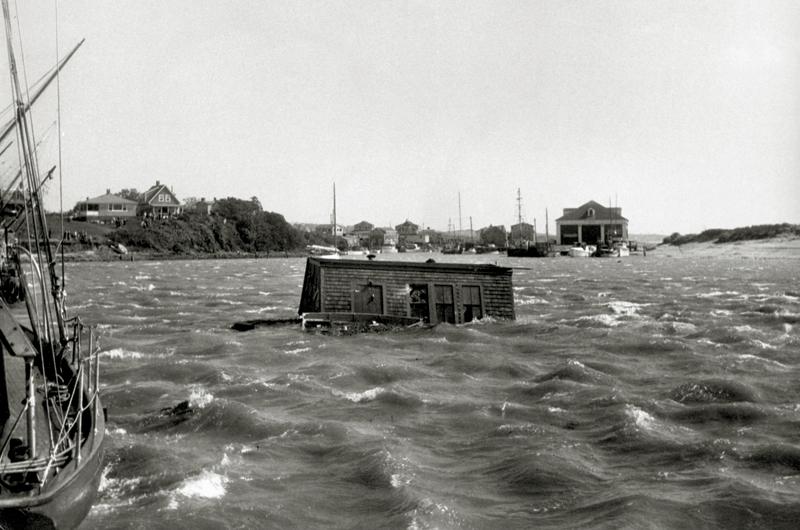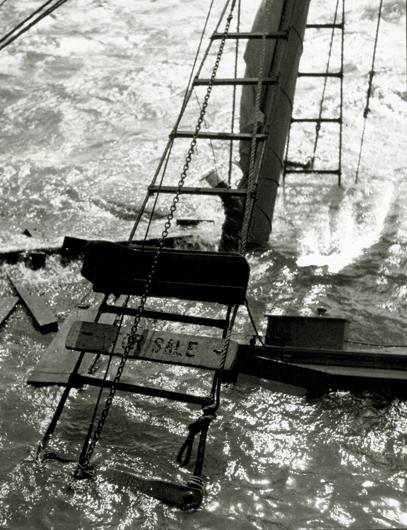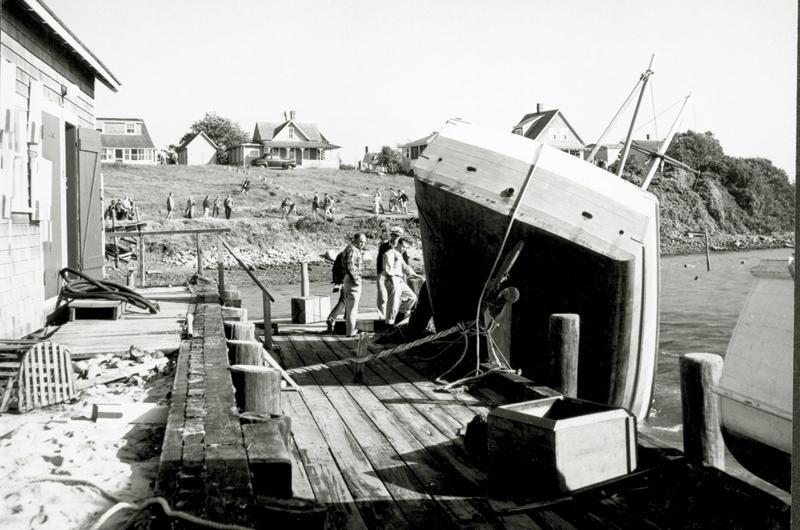Since Hurricane Katrina, people seem to be taking hurricane warnings more seriously. But there was a time when they didn’t. And there was a time when we didn’t even get warnings of impending hurricanes.
In 1954, we were a young family living in West Tisbury in what was then the parsonage of the Congregational Church. It was across the road from Johnson Whiting’s house, which still showed evidence of the 1938 hurricane: three elm trees, toppled by the high winds, were lying crisscrossed in the front yard.

That Monday evening of August 30, 1954, was rainy and windy, but not alarmingly so. We made sure the windows were closed and went to bed, hoping it would be beach weather on Tuesday. In those days we had no TV, and we never listened to the radio for anything but entertainment. If there were any radio warnings of the impending storm, we were in dreamland and didn’t hear them.
The next morning, we didn’t need to be told – the storm was howling around us, rattling the windows, tearing down the wires that brought electricity into our home. My husband Johnny went out to the car to listen to the radio and discovered we were in the middle of a hurricane. There was nothing to do but ride it out. We didn’t live near the water, and we had no big trees near our house, so we weren’t really frightened. However, that summer Johnny was working as skipper of the Aphrodite, a private yacht tied up in Menemsha, and he worried about the boat, as the owner, Nelson Blount, had left the Island for a few days.
The storm seemed to let up after breakfast, and we went outside to survey the damage. Wires were down, hanging from the trees and the corner of our house, and we didn’t know if they were live, so we went back inside and tried to call Mike Athearn on Music Street, who at that time worked for the electric company. But then the wind and rain returned in a fury – we had gone out as the eye of the storm passed over the Island.

Hurricane Carol finally blew itself out, and early in the afternoon we got into the car and headed up to Menemsha. Sticks and branches littered the roadway as we drove slowly up Middle Road, but fallen trees had already been cleared away. We turned onto Tabor House Road, which hadn’t yet been paved, and continued on North Road down the hill into the village of Menemsha. At that time, Menemsha was a real fishing port – no restaurants, no grocery store, and especially, few tourists. There was one small fish market, owned by Everett Poole.
We found a small crowd of people gathered at the entrance to Basin Road, but the police had cordoned it off and were allowing people to pass only if they had connections to boats or buildings. When we got permission from the police, we walked to the harbor.
As we came around the last curve, we were greeted by a scene of absolute devastation. There was hardly a boat left where it had been just the day before. Masts and bowsprits stuck up out of the water to mark the graves of once-beautiful vessels. Whole boats lay smashed on Dutcher Dock, and one or two small buildings floated in the middle of the harbor.

Two of the three large yachts, the Aloysius and the Seer, which had been tied up at the far dock, side by side near what is now the gas station, had survived, but the Aphrodite, on the inside slot, was resting on the bottom of the harbor. Only the tip of her swordfishing stand was above water, to show where she had come to rest. The huge tide had lifted the Aphrodite and set her down on one or two pilings, which sealed her fate.
Herb Slater of the Aloysius and Frank Cyganowski of the Seer, who were both living on their boats, had been awakened by the Coast Guard as soon as it got the hurricane warning, early in the morning before dawn. They were able to take the steps necessary to save their boats, but the Aloysius and the Seer floated in a solid mass of bits and pieces of wood and what had been furnishings.
Small boats had been tossed up onto the parking lot, which now looked like an extension of the beach – sand everywhere. In more than one case, a boat had gone down bow first and left only the stern showing the name of what had once been a prized possession. One mast still had the “For Sale” sign on it that had been put there only days before by the owner, who now appeared to have no boat to sell.

The dock was so cluttered with debris it was impossible to walk on it, so we started down the middle of the road. What few people were there seemed stunned by the wreckage of what had once been a small, picturesque fishing village. While once Chilmark fishermen sold their daily catch here, it now seemed they had lost their livelihood. Everett Poole’s fish
market had been destroyed.
While Johnny went in search of Herb Slater and Frank Cyganowski, I took advantage of the fact that I was one of the few people being allowed in the basin. I began taking pictures of the damage in and out of the water. One other person was there with a camera, and a few fishermen were about trying to find their boats, but mostly the area was deserted. I snapped three or four rolls of black-and-white film, and then we started home.
I realized, when we returned home, that I couldn’t get my film developed; the entire Island was without electricity, and who knew when we would get it back. On an impulse, I wrapped the undeveloped rolls of film together and mailed them off the next day to Life magazine, still a weekly publication back then. My cover letter explained how I happened to take the
photographs.
The editors developed my film, made contact sheets of all the photographs, and even enlarged several of them. They wrote me a thank you note and enclosed $10, and returned it all to me. The next week, when Life came out, it was clear to me why I hadn’t made a first sale to a national magazine. The other person on the dock taking pictures of the wreckage was Alfred Eisenstadt, on the staff of Life magazine, and on his annual, end-of-the-summer vacation at the Menemsha Inn.



 1 comment
1 comment
Comments (1)